 |  |
By Jay D. Gittens
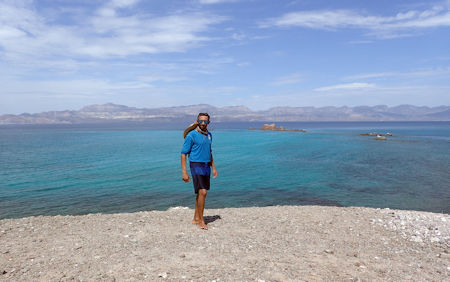
As we set off by road from the center of La Paz, my buddy James and I share in the excitement of our forthcoming adventure; to partially circumnavigate Isla San Jose as well as check out the neighbouring islas of San Francisquito and El Pardito by sea kayak. These islands lay in the Sea of Cortez some 40 nautical miles north of La Paz. A 2.5 hour drive takes us to the small village of San Evaristo. Along the way we observe miles of sedimentary rocks, cliffs and mountains painted green by the vast deposits of phosphate minerals. Halfway into the drive, the paved road becomes dirt which eventually snakes its way through the rocky mountain range.
Arriving to San Evaristo we are soon greeted by the welcoming smiles of the happy locals. After test-packing our sea kayaks, we load them onto the 26 feet panga we chartered and set off out of the bay and across a bouncy channel.
Roughly half-way to our drop-off point, we pass by “Los Lobos”, a group of rocky islets that provide hauling-out space for around 40 California sea lions. In our general chatter, we unwittingly disturb the alpha-male from his rest. Raising his huge bump-head, he gazes in our general direction and offers a few half-hearted barks before quickly returning sound to sleep. Several juveniles frolic in the shallow emerald-clear waters surrounding the rocks.
We proceed on to Playa El Corralito on Isla San Franscisquito where our boat captain helps us off-load our kayaks. The small sheltered bay that wraps the beach has 10 or 12 yachts anchored just offshore and their tenders and various aquatic toys shuttle to and fro between them. The intense heat of this summer afternoon demands that we immediately raise our shade to keep us as cool as possible. As we are setting up camp, my gaze keeps favouring towards the crystal-clear water. Not more than a few minutes pass before we agree to temporarily abandon our camp duties to free-dive amongst the healthy coral and abundance of fishes. The water is super-fresh and welcoming to our sun-exposed bodies. 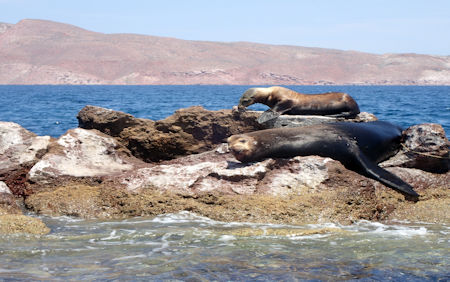 On swimming back to the beach towards our partially erected campsite, the slight offshore current gives me a firm yet forgiving reminder of why it’s generally best to don your fins when snorkelling or free-diving in the ocean. I kick and stroke away until I am beached. We complete our home for the night before cooking freeze-dried lasagne and stove-top pizza, both of which turned out to be delicious. I am only missing an ice-cold beverage. Between 2 kayaks, we have to pack everything we need to survive for several days and of course ice isn’t one of them.
On swimming back to the beach towards our partially erected campsite, the slight offshore current gives me a firm yet forgiving reminder of why it’s generally best to don your fins when snorkelling or free-diving in the ocean. I kick and stroke away until I am beached. We complete our home for the night before cooking freeze-dried lasagne and stove-top pizza, both of which turned out to be delicious. I am only missing an ice-cold beverage. Between 2 kayaks, we have to pack everything we need to survive for several days and of course ice isn’t one of them.
The next day we prepare a tasty breakfast starting with coffee. As we are packing up, a tender boat from the yacht in front of our campsite pulls up on the beach. The two crew members approach us with cooked breakfasts and ice-cold drinks. Pity we had already eaten but we force as much of the secondary breakfast down as possible in anticipation of requiring the energy later on. My ice cold water and can of soda goes down a treat. Once the kayaks are fully packed, we paddle over to the yacht to say a thank you before proceeding to the island of El Pardito.
Isla El Pardito is a small rocky island that is home to around 20 or so families. Exactly why the originators of this small community chose to partially isolate themselves on this relatively small rock remain a mystery to me. I like to think that it’s quite simply because they had found their paradise. Having beached our kayaks, we were immediately approached and welcomed by a few of the male inhabitants who gave us their blessing to have a look around their island. Man-made steps and slopes lead us past the homes of several smiling families before placing us at the summit. The 360 degree view is utterly striking, displaying much of what is characteristic of the islands of the Sea of Cortez in a mere moment. The water as far as my eyes can see is lake calm and ranges in colour from emerald green through deep blue. After snapping some memories we board our kayaks and head towards a large mangrove area on our main destination of Isla San Jose.
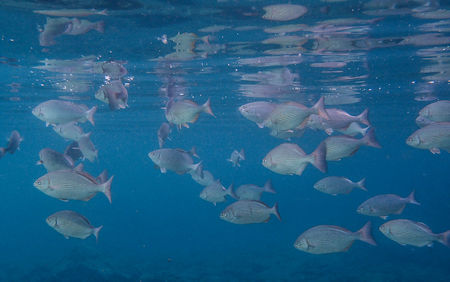
Covering an area of some 70 square miles, Isla San Jose is the 6th largest island in all of Mexico and possibly one of the most diverse in terms of biology and landscapes. We paddle up to a small peninsula located on the south-eastern tip of the island that is composed of a sand-spit covered by dense mangrove forest. The greens are vibrant and lush and the water varies in colouration influenced by depth and seabed composition. Above water, the chatters of tropical bird talk deny silence. The tranquillity of this place grabs me from the outset. We continue on towards our first base camp at the mouth of an arroyo.
Landing at the arroyo was tricky at best. The shore consists of rounded pebbles to boulders and the ocean was surging back and forth. Once we landed and carried the kayaks clear from highest tide, it was straight into the ocean to cool off and explore the marine life. The sea bed is a mixture of algal-covered rocks and rocky coral tapering down into murky sandy-bottom depths. I wonder what weird and wonderful creatures occupy the space just beyond my vision at this present moment in time.
After our swim we head hiking up the arroyo, penetrating it by perhaps two or three kilometres. The high cliffs put us in our place in terms of size. The arroyo is lined with lush-green foliage, evident of recent rains. Goats stand over us watching, introduced here many years ago. I’m somewhat amazed by how their hoofs grip at the loose rocks as they climb up the slopes to put a little more distance between us and them. Over-head, a hawk squawks loudly as it occupies a vantage point on the tallest available tree. Eventually it flutters upwards before turning with the wind to sweep gracefully away over our heads. Dinner is followed by star-gazing and an early night. A cooling breeze blows down the arroyo throughout much of the night making for a comfortable nights rest.
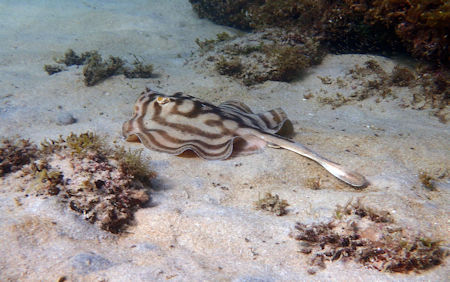
The following day we are up at sunrise, gradually packing the kayaks for the next leg. Our next base camp is 13 miles away point-to-point. Half-way there, we come to a rocky point called “Punta Colorada”, so-called due to the striking red coloration of the rocks and cliffs. We stop here to cliff-jump and snorkel around some amazing rock formations. The numbers and size of the fish here suggest that this area is in very good health. Large schools of yellow-tailed surgeonfish graze the algae on the rocks and coral. Huge bass lurk in the dim light under rocky overhangs. Sea stars, urchins and sea cucumbers are peppered all over the rocky seabed and between coral heads. After exploring this little marine oasis we get going again towards our second base camp. The final three miles challenge my strength and stamina. Finally we land at Cuatro Palmas and once again it’s straight in the ocean to cool-off and explore. Huge schools of fish hang almost motionless in the water column. Several stingrays lay partially buried in the sand, waiting for something to ambush. Large gorgonian sea fans decorate the rocks creating the impression of an underwater garden. The cliffs are sandstone that has been intricately sculptured by the winds into something resembling honeycomb. A huge dinner is followed by a magical sunset that just kept improving with time until darkness finally absorbed the light.
We wake very early the next day to a fantastic sunrise. It’s the final day of this adventure. We set off paddling towards the northern-tip of Isla San Jose. On the way a small pod of bottlenose dolphins gift us for a moment. We soon pass through several compelling rocky arches that had long ago been carved out by sea and wind. It feels very quiet and lonely here, the only sound being that of my paddle dipping with each stroke into the ocean as I progress onwards. At the northern-tip, the crystal clear visibility of the surrounding water gives us reason to beach the kayaks and explore the marine life. Huge rocks, some of which break the surface, litter the seabed attracting all kinds of life. This will be our final stop before paddling the last 2 miles to our extraction point on the north-west of the island. We radio ahead for our pickup and beach for the last time before being ferried back to San Evaristo.
Isla San Jose is an astonishing place that is largely untouched by tourism due to its relative remoteness. The diversity of its landscapes and abundance of wildlife are nothing less than remarkable and would be a great attraction to any nature-lover willing to go that extra mile. If sea kayaking isn’t for you, you may consider a boat tour or a liveaboard trip as an alternative.
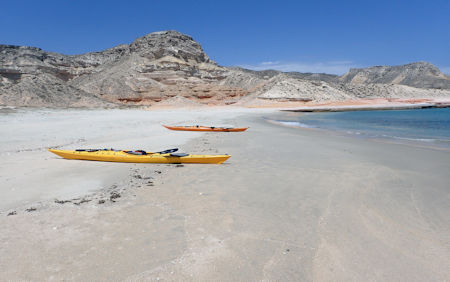
You can contact me directly for information about trips to Isla San Jose.
Email: jaydgittens(at)gmail.com
Cell phone: +52.612.197.5824